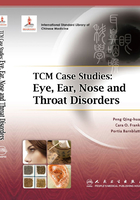
上QQ阅读APP看书,第一时间看更新
Chapter 10 Chronic Conjunctivitis
Conjunctivitis is typically an acute patern; however, both infectious and allergic conjunctivitis can become chronic. Conditions that lead to chronic conjunctivitis include ectropion, entropion, blepharitis and chronic dacryocystitis. Furthermore, its occurrence is associated with blepharitis and rosacea. Bacterial conjunctivitis can also develop into a chronic condition.
In TCM, chronic conjunctivitis can also be referred to as bái sè zhèng (白涩症, white dry eye or white xerotic syndrome). It is characterized by mild redness or thin red veins in the sclera with dryness and discomfort. The disease is often caused by incomplete treatment of fulminant wind with an invading fever, or as part of the sequelae of acute contagious conjunctivitis where there is lingering heat hidden in the sclera. Other factors include an inability to control one’s diet, excessive smoking or drinking alcohol and excessive consumption of spicy-hot food. These lifestyle habits result in damp-heat accumulation in the spleen and stomach with inhibited qi movement, resulting in pathogenic stagnation in the sclera. Other possible causative factors include a lack of nourishment to the eyes due to lung yin deficiency and fluid loss, liver and kidney deficiency or yin and blood deficiency resulting in a lack of fluid and tears, all of which result in malnourishment of the sclera. This etiology is associated with imbalance among the organs of lung, spleen, liver and kidney. The paterns include excess, defciency or the combination of excess and defciency.